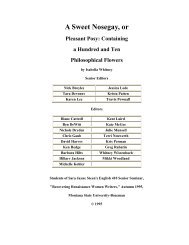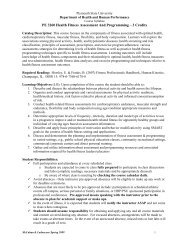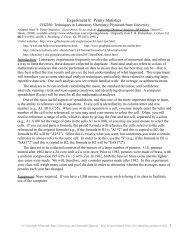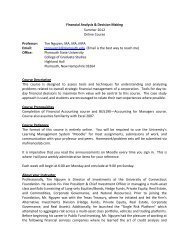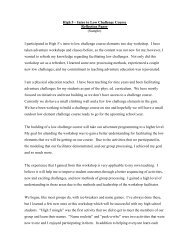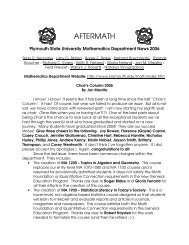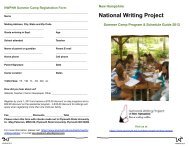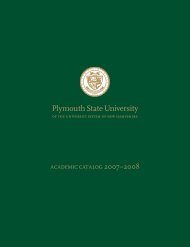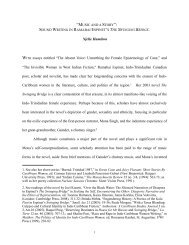Tiger Curriculum Connections - Plymouth State University
Tiger Curriculum Connections - Plymouth State University
Tiger Curriculum Connections - Plymouth State University
You also want an ePaper? Increase the reach of your titles
YUMPU automatically turns print PDFs into web optimized ePapers that Google loves.
<strong>Plymouth</strong> <strong>State</strong>T.I.G.E.R.<strong>University</strong>ProgramApril-2013InsideTIGERCUB CLUB ............TIGERTALE...................TIGERTEEN ..................TIGER ACTIVITIES .........TIGER TEACHER ............TIGER CONNECT TOCURRICULUM.......TIGERTOMES ................TIGERTUNE.................. 9TIGERTIMEOUT ............. 1314TIGERTIME RESEARCH .......2345678Vol. 13 Issue 5 - TIGER ONLINECURRICULUM CONNECTIONSTIGER NEWS ALERTSPRING IS ON IT’S WAY ANDTIGER HAS SOME EXCITING NEWS.TIGER has performed regionallythroughout New England, nationally andinternationally. And this summer, wehave been invited to perform at theIDEA WorldCongress inParis, France.TIGER IS ONFACEBOOKClick on TIGER and go toour FaceBook page and“Like.” Follow our storiesand our Troop in theirtravels around NewEngland.
TIGER CUBClubThe Caterpillar's Voice1. Read the story first, then identify the different animalsin the story.2. Identify key characteristics for each of the animals.3. Discuss the types of homes and the environmentalcharacteristics for each of these animals. (A hare livesin a burrow.)4. With the students, identify where the Maasai peoplelive in East Africa and discuss the characteristics oftheir homes.5. Compare and contrast the homes of the students in theclass with the homes of the Maasai people.TheaterA. Divide the class by the number of animals from thestory. Each cluster works together to create thatanimal, acting as though they are that animal.B. The groups then present their animal to the rest of theclass and listen to suggestions that might make theiranimals more believable.C. The teacher then reads the story aloud and the entireclass participates as the characters.HISKER WISDOMDON’T BE A BYSTANDER.SAY “NO” THIS IS NOT OK!”Visual ArtA. Define and discuss the term scene.Identify the characteristics of“scenes” in the story.B. Each group draws their “scene.”C. Place the drawings on a board andlook at them as a class to identifymissing scenes. Students thenwork to “fill in the gaps.”Maasai People of Kenya - Fast Facts•Maasai houses are loaf shaped andare made of mud, sticks, grass and cowdung. Women are in charge of makingthe houses while men are in charge ofmaking kraals. (animal fences andsheds)•Cattle, goats and sheep are veryimportant for Maasai. They barterthese for food, cash and other livestock.•Most Maasai kids don’t have TV towatch or books to read but now haveaccess to education.•Children play a game called “TheCircle Game” The leader(s) call out,"One, two...make a circle...Three,four...a BIG Circle." The children holdhands and form a growing circle. Then,the leaders call out a game. Games aresimilar to Duck, Duck, Goose..a groundversion of Marco Polo and Simon Says(yama yama yama).CLICK HERE FOR YOUTUBE2
TIGER TaleA Caterpillar's VoiceFolktale from Maasai: East AfricaOnce upon a time a caterpillar crawled insidea hare's house when the hare was away, and setabout making himself comfortable. When the harereturned home, he noticed new marks on theground going into the burrow. He called, "Who's inmy house?" The caterpillar boomed out in a loudvoice, "It is I! Yes, I who crush rhinos to the earthand trample elephants into dust!" The harehopped about, crying, "What can a small animallike me do with a creature who crushes rhinos andtramples elephants?"The hare soon met a jackal, and asked thejackal to talk to the terrible creature who hadtaken possession of his home and to convince himto leave. The jackal agreed, and when they reachedthe place, he barked loudly and said, "Who is in thehouse of my friend the hare?" The caterpillarreplied in a voice that rocked the earth, "It is I!Yes, I who crush rhinos to the earth, and trampleelephants into dust!" On hearing this the jackalthought, "Certainly I can do nothing against such acreature," and he quickly left.The hare then fetched a leopard, and he beggedthe leopard to help him. The leopard assured thehare it would be no trouble at all. On reaching thespot, the leopard bared his claws and growled,"Who is in the house of my friend the hare?" Thecaterpillar replied in the same manner as he haddone before.thought, "IfThe leopard was alarmed andhe crushes rhinos andelephants, I don'te v e n w a n t t othink aboutwhat he coulddo to me!"Next the haresought out the rhinoceros. "No doubt, I am themost fearsome of beasts," grunted the rhino.The rhino marched to the hare's burrow, wherehe snorted and pawed the ground with hismassive feet. But when the rhino asked whowas inside and heard the caterpillar's boomingreply, he thought, "What, he says he can crushme to the earth?" And the rhino thunderedaway, crashing through the forest.Growing frantic, the hare tried theelephant, and asked him to come to hisassistance. But like the others, on hearingwhat the caterpillar had to say, the elephantknew that he had no wish to be trampledunderfoot like dust, and stomped off.In despair by this point, the hare asked afrog passing by if he could possibly make thecreature who had frightened all the otheranimals leave his house. The frog went to theburrow door and asked who was inside. Hereceived the same reply as had been given tothe others. Then the frog went nearer andshouted, "I, who am the strongest of all, havecome at last. I am the one who crushes thosewho crush the rhinos! I am the one whotramples underfoot those who trample theelephants!"When the caterpillar inside the hare'sburrow heard this, he trembled. He sensed theshadow of the frog coming nearer and thought,"After all, I am only a caterpillar!" And thecaterpillar inched out of the hare's den alongits edge, trying not to be noticed.The animals who had collected around thehare's house seized the caterpillar and draggedhim out. "What, you?" they all cried indisbelief."I would never dream of staying in thatburrow!" said the caterpillar with his nose inthe air. "An echo like that is far too crude for arefined creature like myself!" As he sniffedaway, all the other animals laughed at thetrouble he had giventhem.3
4TIGER TEEN
TIGER ACTIVITIES•Bullying Myths & Factsfrom www.bullying.org•Myth: “Bullying is just a stage, anormal part of life. “I went throughit––my kids will too.”•Fact: Bullying is not “normal” orsocially acceptable behavior. Wegive bullies power by ouracceptance of this behavior.•Myth: “If I tell someone,it will just make it worse.”•Fact: Research showsthat bullying will stopwhen adults inauthority and peersget involved.•Myth: “Just stand upfor yourself and hitthem back.”•Fact: While thereare some times whenpeople can be forcedto defendthemselves, hittingback usually makesthe bullying worseand increases the riskfor serious physical harm.•Myth: “Bullying is as c h o o l p r o b l e m , t h eteachers should handle it.”•Fact: Bullying is a broadersocial problem that oftenhappens outside of schools,on the street, at shoppingcenters, the local pool,summer camp and in theadult workplace.•Myth: “People are bornbullies.”•Fact: Bullying is a learnedbehavior and behaviors canbe changed.Community Building1. THE TRUTH ABOUT ME - Description: Studentsshare aspects of their lives with each other. Aparticularly useful activity in a language classroomto encourage students to communicate andcomprehend.Students gather in the center of the space. Onestudent who volunteers to step away from the groupsays, “The truth about me is . . .” and completes thephrase. For instance, “The truth about me is I like togo hiking.” Everyone who shares that interest movestoward the student and forms a group around her.Another student steps out of the initial group andmakes another statement: “The truth about me is Ilike the television series The Sopranos.” One by one,students step out of the various groups that formaround the room, stating new “truths” and formingnew groups.In a more structured variation, each student in theclass receives a number. When you call out thestudent’s number, he steps out of the group andgives his statement. Others who agree form a groupwith the speaker at the center.In another variation, students form a large circlearound the perimeter of the room. With a piece ofmasking tape, each student marks his spot on thefloor. One student is left without a spot. Thatstudent stands in the center of the circle and makesa statement. All those who share the same truthmove into the center of the circle and stand with thestudent. The student who made the statement callsout, “1, 2, 3, go!” and everyone runs to capture anempty spot. One student will be left without a spot.She then goes to the center and makes herstatement. The activity continues.Reflection: What are some things you learnedabout your classmates today? Did you hear anythingthat surprised you?5
TIGER TeacherBUILDING COMMUNITY6What does theResearch Say?85% of bullying episodes occurin the context of a peer group.83% of students indicate thatwatching bullying makes themfeel uncomfortable.Bullying stops in less than 10seconds, 57% of the time whenpeers intervene on behalf of thevictim.2% reported being both bulliesand victims.Bullying occurs in schoolplaygrounds every 7 minutes andonce every 25 minutes in class.Bullying is reduced in a schoolif the principal is committed toreducing bullying.Bullies often come from homesthat are neglectful and hostileand use harsh punishment.Bullying may be learned byobserving high levels of conflictbetween parents. Care needs tobe given so that they do notmodel bullying for their children.Sources: Atlas and Pepler, 1997,Craig and Pepler, 1997, Charachet al., 1995 & Olweus. 1993Excerpt from “A Reason To Read: Linking Literacy and the Arts”by Eileen Landay, & Kurt Wootton & Shirley Brice HeathLanday, E., Wootton, K., & Heath, S.B. (2012). A reason to read:Linking literacy and the arts. Cambridge, MA: Harvard EducationPressNote from Timm––I had the pleasure to work the Eileen and Kurt a fewyears ago. Their work in integrating the arts through buildingcommunity creates spaces that are caring, safe and work towards therigor that students need in approaching literacy and academics.In Literacy, Community, and the Arts, the course we developedand taught from 1998 to 2006 for Brown <strong>University</strong>undergraduates and graduate students, each student wrote aliteracy autobiography. Virtually every one of their storiesdescribed a relationship with at least one person–parent, friend,teacher–who loved and mentored them and inspired them tobecome fluent readers and writers. Many described hearingfamily members read to them at an early age. 4 One studentwrote, “Me at age five with my older brother and my twin allperched (as I remember it) on my father’s belly while he lay inbed reading J.R.R. Tolkien’s Lord of the Rings aloud. If only myfather’s voice could continue the story forever!” 5While their presence in an Ivy League university classroomtestified to their academic achievements, the students who wrotethese essays came from a rich mix of ethnic, social, and economicbackgrounds. We were struck by how vividly they described theconnection between these literacy events and their academicdevelopment. What would it take, we wondered, to createclassrooms where all students could experience a similar level ofsupport, where in addition to supporting one’s intellectualdevelopment, the act of reading and writing would forge warmrelationships among it’s members? Such a climate may exist inthe very early grades in classrooms but appears to diminish andusually disappears as students grow.Anonymity in daily life in school–especially large, urban secondaryschools–is hardly news to anyone whohas spent much time in them. Thepotential for a classroom to be acommunity often goes unrealized.Our experience in schools hasdemonstrated the value of communitybuilding in secondary school literacy
work. When students feel they are in a supportivecommunity––filled with what we refer to with the Portugueseword alegria––they are willing to focus, work hard, and takerisks. 6 Community is built in students’ and teachers’ hearts,and there are no easy games or gimmicks for achieving it inthe classroom. Nonetheless, we have learned the importance ofcreating an environment in the classroom that encouragesstudents to share their work and make genuine efforts to learnand grow.Learning takes place most effectively in situations wherepeople feel a sense of belonging to a group whose purposes andactivities matter to them and can help them grown in waysthey find rewarding. Students benefit from knowing that theyare important to the other members of the community. 7 Aproductive learning environment is created by establishing ashared purpose, supportive relationships, and a regularrepertoire of routines and activities in the classroom.“Engagement in social practice is the fundamental process bywhich we learn and so become who we are” 8Building a community “does not necessarily refer to a sense ofharmony but, rather, a shared set of social practices andgoals.” 9 When a group of learners sets out to explore, create,and perform their response to a theme or compelling question,the ultimate purpose of their learning is clear and meaningful.Supportive relationships include connections between adultsand students as well as between students and between adults.Routines are the daily activities that build group identity.They focus participants’ attention and energy; offer clear,Continued on page 17I think tolerance and acceptance andlove is something that feeds everycommunity.~ Lady GagaWe are interested in including your ideas, photography, artworkand writing in upcoming TIGER Publications.CONTACTING T.I.G.E.R.PAMELA IRISH pmirish@plymouth.eduTIGER NewsletterTrish Lindberg, Artistic Director, editor, contributorTimm Judas, designer, photography, contributorMax Judas, TIGER drawingsAmy Maki, editorSinger & ActivistTIGER Connect to<strong>Curriculum</strong>The following suggestions are ways toextend and integrate communitybuilding into curricula.THE BASIC TABLEAUA. Description: A tableau is a frozenimage of an event, activity, orconcept.B. Duration: 20 minutesC. Preparation: Students can createtableaus to represent their variedinterpretations of a given text oridea. Students can work from words,phrases, or larger narratives wherethey form images of the “big events.”D.Procedure: Groups of four to sixstudents form a tableau that mayreflect the vision of a single “sculptor”or a collective creation of the group.Before beginning the activity, offer asimple set of guidelines, suggesting,for example, that everyone in thetableau is physically connected orpositioned at different levels in space.Many variations are possible,including creating snapshots—tableaus presented in a series withcarefully orchestrated transitions—or tableaus that move or speak.Music played as tableaus areformed and displayed to the groupcontributes to the activity. When theactivity is completed, discussionabout both the content and theprocess increases awareness andunderstanding.E. Reflection: Where did we seesimilarities across the images? Wheredid we see variations? What are thelimitations of tableaus? Did thoselimitations help you or hinder you?7
TIGER TomesThe Tripby Ezra Jack KeatsPreK-3rd GradeOne of Keats’s best-loved characters, Louie, stars in this poignant storyabout the loneliness of moving to a new place. Homesick for his oldneighborhood, Louie finds a way to return—by making a shoe box modelof where he used to live, and pretending he is inside it. But soon, Louiewill discover that he doesn’t need to use his imagination to find friends; infact, they may be as close as his new front door.A Light in the Atticby Shel Silverstein3rd-6th GradeHere in the attic of Shel Silverstein you will find Backward Bill, SourFace Ann, the Meehoo with an Exactlywatt, and the Polar Bear in theFrigidaire. You will talk with Broiled Face, and find out what happenswhen Somebody steals your knees, you get caught by the Quick-Digesting Gink, a Mountain snores, and They Put a Brassiere on theCamel.From the creator of the beloved poetry collections Where theSidewalk Ends and Falling Up, here is another wondrous book ofpoems and drawings.Three Times Luckyby Sheila TurnageMiddle SchoolRising sixth grader Miss Moses LoBeau lives in the small town of TupeloLanding, NC, where everyone's business is fair game and no secret is sacred.She washed ashore in a hurricane eleven years ago, and she's been makingwaves ever since. Although Mo hopes someday to find her "upstream mother,"she's found a home with the Colonel--a café owner with a forgotten past of hisown--and Miss Lana, the fabulous café hostess. She will protect those she loveswith every bit of her strong will and tough attitude. So when a lawman comesto town asking about a murder, Mo and her best friend, Dale Johnson III, set out to uncover the truthin hopes of saving the only family Mo has ever known.Full of wisdom, humor, and grit, this timeless yarn will melt the heart of even the sternest Yankee.8
TIGERTunesITIGER Theme SongLyrics by Trish LindbergMusic by William Ögmundsoncan make it happen, I can make it right. I can tell a teacher,I can tell some friends. I can tell my motherTogether we’ll make it end.I can make it happen, I can make it right. I can tell them“stop it!”I can tell them “whoa!”I can be the strong one.The person who just says no.Tell an adult what’s going on and say “no” right away. Pleasedon’t gossip with your friends, exit don’t stay. Everyonedeserves respect each and every day.You can make it happen. You can make it right. If you tell astory.If you dis your friend.It starts a cycle that never will have an end.You can make it happen. You can make it right. When otherkids are fighting they’re putting on a show. Though it seemsexciting you really ought to go.Tell an adult what’s going on and say “no” right away. Pleasedon’t gossip with your friendsThere’s not point in acting that way.Everyone deserves respect, each andevery day. We can make it happen. Wecan make it right.Bullies love attention, they want to bea star. You can take their power byrespecting who you are.Everyone deserves respect each andevery day. Everyone deserves respecteach and every day!9
T.I.G.E.R. at <strong>Plymouth</strong>TIGER (Theatre Integrating Guidance, Education,and Responsibility), recipient of a 2011 NewHampshire Partners in Education Gold Circle Award,is a powerful and exciting collaboration between theintegrated arts and the counselor education graduateprograms at <strong>Plymouth</strong> <strong>State</strong> <strong>University</strong>. TIGER is aprofessional theatre company designed to helpchildren, schools, parents, and communities dealproactively and positively with social issues andconcerns facing children in schools today.TIGER Time OutActivities for Teachers &Students to do Together<strong>Plymouth</strong> <strong>State</strong><strong>University</strong>T.I.G.E.R.ProgramTo Book TIGER pleasecontact Pamela Irish,TIGER Tour Managercall (603) 535-2647fax (603) 535-2879.Poetry MattersApril is National Poetry Month - Studentscreate grade appropriate poetry with the themeof Anti-Bullying, Community, Friendships,Diversity or Tolerance. If this were a schoolwideevent perhaps each classroom or gradecould present poetry around a different themefrom the above suggestions.1. Teachers facilitate a discussion withstudents about the theme around which thestudents will be writing their poems.Creating a word back or important wordsthat could be used in the poetry.2. Teach is done in connection to gradeappropriate poetry style that students will use in writing their poetry.3. Students write their poems and present them to the class.4. Teachers facilitate discussion about how to adjust the poems.“What do we like about the poem?” “What would we adjust if it wereour poem?”5. Draw and cut out colorful letters spelling out Poetry Matters. Blackmarker can be used to add details as needed. Place letters on bulletinboard.6. Students place their final printed poems on the board.7. Pick a special day for students to read their poems aloud to otherclasses. If a school-wide project, rotate between classrooms whereclasses can present their poems to others.8. Students write a thank you for a poem that they especially likedand give it to the young author, or post them on the bulletin boardnext to the poems.See you next issue.13
TIGER TALKS RESEARCHSECURITY/LIFE SAFETYBullying PreventionThrough modern bullying-preventiori strotegies,schools can be rriore efficient in their response,more colloborotive and more occountable.BY KATIE JOHNSONThe nation watched in shock ily, and chuckled as they made violent might have gone unnoticed and unrerecentlyas four middle school and graphic threats. ported, had not one of the teenagersboys barraged 68-year-old bus We also watched as Klein remained posted a 10-minute video of the hamonitorKaren Klein with jabs quiet, taking the abuse and failing to rassment on YouTube.about her weight, attacks on her fam- respond to the students. This incident As the video went viral and supportStudents don't report buiiying tor many reasons: they may fear retaiiation from a buily; they may teei the reports wiii be ignored orthat the buiiying will become even worse; and often, students don't know where to turn.1434 AMERiCAN SCHOOL & UNiVERSiTY • ASUMAG.COM • SEPTEMBER 2012
SECURITY/LIFE SAFETYCyberbullying via text or the Internet is another way students can be bullied, and it isimportant tor schoois and universities to have reporting measures in place.poured in for Klein, many educationinstitutions and parents began askingthemselves: "Could that happen onour buses, in our community, at ourschool?"LESSONS LEARNEDValuable lessons may be learnedfrom this incident that could helpprevent such incidents from occurringor escalating in schools.Do school administrators have anyclue what is happening to students,bus monitors or drivers on the way toand from school?And perhaps more important, arebus monitors and drivers trainedproperly with the right informationon how to respond if students areabusing or buUying them? Do the busmonitors understand their roles andresponsibilities for responding to thebullying or harassment of students?What role do the monitors have in thesafety of the students on the bus?In the recent documentary, "Bully,"one of the students featured wastortured and bullied daily on the bus,but because of a lack of awarenessand reporting, school administratorsand parents were clueless about thesituation. How can institutions ensurethat they are made aware of theseincidents?A FAILURE TO REPORTThese incidents and others clearlyshow drastic disconnects betweenschool administrators and policy, andwhat is happening on buses, in lockerrooms, in hallways, at sporting events,online and numerous other locationsA comprehensive incident-management systemensures ail incident reports are tracked, documentedand addressed proactively.where bullying and abuse is takingplace.In recent studies, 65 percent ofvictims said bullying was not reportedby them or others to teachersor school officials. Even when a bullyingvictim had suffered injury, 40percent of the time the students saidthe bullying was not reported. In fact,studies show only one or two out ofevery 10 incidents are being reported;80 to 90 percent of incidents are unreportedand school leaders remainin the dark.These incidents remain unnoticedfor many reasons. Students may fearretaliation from a bully or don't wantto he embarrassed. They may feeltheir reports will he ignored or thatreporting it will make the situationworse. Many times students don'tknow where or whom to turn to;they don't trust the administrationor law enforcement, or they mayhave not a way to report an incidentanonymously.PREVENTION STRATEGIESThe Office of Civil Rights requiresschools to investigate bullying incidents,and take immediate actionto stop harassment and prevent itsrecurrence. If a school knows or reasonablyshould know about studentharassment and fails to address itseffects and take appropriate action, itis opening themselves up to federalinvestigations and expensive lawsuits.School districts and higher-educationinstitutions must establish comprehensivepolicies and procedures foridentifying, reporting, investigatingand responding to incidents of bullyingand harassment.Several Midwest schools, includingTulsa Public Schools, are takingproactive action to empower theirstudents, personnel, parents and othersto report incidents (anonymouslyor not).These schools are using innovativerisk and incident management andthreat assessment tools to encouragestudents, teachers, staff and othersto confidentially and anonymously3 6 AMERICAN SCHOOL & UNIVERSITY • ASUMAG.COM • SEPTEMBER 201215
eport bullying or other potentiallyharmful student behavior. In additionto bullying and cyber-bullying, anincident-management system enablesstudents and staff to anonymouslyreport weapons possession, drug/alcoholuse, harassment or intimidation,school vandalism, physical assault,threats of violence, suicide risk, abuseand other incidents.REPLACING THE STATUS QUOA comprehensive incidentmanagementsystem ensures all incidentreports are tracked, documentedand addressed proactively. With aWeb-based platform, for example,school administrators can access ondemandreporting to see when reportsare made, when team members receivedand acknowledged each report,and what steps were taken to addressthe report.A comprehensive platform willensure incident reports (and videos.Screenshots, etc.) get to the rightpeople immediately so they can investigate,intervene and prevent incidentsbefore they lead to tragedy or go viral,ending in costs (legal, reputation, media,parent outrage, stress, investigations,fines, etc.) that could have beenprevented.Innovative platforms are replacingtraditional incident-reporting processesand programs and automatingwhat was once a labor-intensive andexpensive manual process of documentation.Team members collaboratethrough the platform to share ongoingfindings and help connect all the dotsneeded to ensure a safe and responsiveapproach. The ability to loadmandated policy, training, updates toprocess or procedure, etc., make thisapproach cost-efficient for institutionstrying to cut costs.Schools can be more efficient intheir response, more collaborative ininterventions and investigations, andmore accountable to students and theirfamilies. •JOHNSON is the director of client servicesand morketing for Awareity, Lincoln, Neb.,a provider of risk management, incidentreporting and prevention platforms.WWW.AWAREITY.COM •WWW.TIPSPREVENT.COMON THE WEBRead the related article "Tackling Bullying Behavior for School Security"in the Security article archives at ASUmag.com.Oo You Want To Talk To Your Electric SubmotorsPE-Mon D-Mon Submeters with Communications IE-Mon D-Mon submeters offer a variety of communication options to enable users to monitor 38+ points of energy datEasily integrate with E-Mon Energy software for billing & analysis, building automation systems and otherenergy monitoring programs with these industry standard communication protocols.TelephoneRS-232I SiInternet ModBusEthernetBACnetWirelessLonWorks16E-Mon D-MonThe Original Submeter^^(800) 334-3666 - wvvw.emon.com
Continued from page 7specific ways for people to connect and interact; and establish a tone of active engagement, playand pleasure combined with seriousness of purpose. They are designed to introduce communitymembers to one another, to foster respect for the resources that each person brings, and to builda positive learning environment.Bobby stands in the classroom doorway at the beginning of every class and shakes his students’hands as they enter the room. As teacher and coach of the school’s championship soccer team,Bobby gives his students an infusion of encouragement and energy. His students joke and laughwith him. When visitors enter the classroom, Bobby makes sure the students are notanonymous by asking them to introduce themselves.From the beginning of the school year, Bobby leads students in physical warm-ups and vocalactivities. These include stretches and movement exercises. Calling out tongue twisters like“red leather, yellow leather” and “you know you need unique New York,” students practice orallanguage skills and hear their voices speaking out in a classroom setting. Trust-buildingactivities give community member opportunities to know one another, to respect the resourcesthat each person brings to the classroom, and to build supportive relationships. Communitybuildingactivities provide a foundation for text-based work by ensuring a supportive learningenvironment. Students know rom the outset their work has a purpose and that they arecreating a performance that will tell their stories to the community at large. To accomplish thispurpose, they engage in questioning, collaboration planning, improvisation, reading, writing,discussion, critique, and reflection. Bobby and Kevin know that after having worked through the“Performance Cycle” once, the class will begin a second round with a far greater sense ofcohesion and solidarity.Although Bobby has been working for some time to build a strong sense of community, on themorning when Kevin asked the students to step on the stage to form a circle, Russellimmediately took hold of the stage’s curtain and wrapped himself in its many layers. Afterencouraging Russell to come out, Kevin joined the other students and began to lead them incommunity-building activities. Russell remained behind the curtain. When we asked Bobbyhow he reacted to Russell hiding in the curtain, he said, “I tried to talk him out. The curtain wasold and dusty. When that didn’t work, I said, ‘Russell, you don’t have to participate but juststand there.’” Bobby didn’t cajole Russell out of the curtainor threaten to send him to the office. He encouraged butdidn’t force him to give up the protection of the curtain.Instead, they engaged in conversations designed to drawhim back into the “classroom.” Together Bobby and Kevinmoved ahead to create the kind of interesting andsupportive community they believed Russell wouldeventually want to join.4.Shirley Brice Heath addressed this topic in detail in Ways withWords, a landmark study of the language socialization of children fromdifferent sociocultural groups and the impact of that socialization onchildren’s school experiences.5.Sarah Blakely-Cummings, “Feliciliteracy,” unpublished paper,Brown <strong>University</strong>, 2005.6.Students in the ArtsLiteracy Project’s Brazil Lab School, piloted inJuly 2006, used the word alegria to describe their learningexperiences, defining it as containing elements of joy, happiness, andcelebration.7.Lave and Wenger, Situated Learning.8.Wenger, Communities of Practice, 1.9.Lee and Smagorinsky, Vygotskian Perspectives, 5.17
TIGER TALK!Roaring reviews from schools who enjoyed TIGERduring last year’s 2011–2012 SeasonPer usual, the troupe was OUTSTANDING!!!I have been a fan of the TIGER programfor years, it has been presented each yearin the various districts I have workedin…Your longstanding team members arestill as fresh and dynamic as ever…Thank you for coming to our school.Bonnie Jean KurasPrincipalSanbornton Central SchoolSanbornton, NHIt was excellent! The whole school reallyenjoyed the performance and I receivedwonderful feedback regarding the breakoutsessions. I was so excited and pleasedwith how it all worked out. I believestrongly in the message you are spreadingand the creative ways you are doing so.I have all intentions of spreading theword to other schools about how great andworthwhile TIGER is.Jennifer Lee-FeinbergSchool CounselorUnity SchoolUnity, NHThe performance was awesome! Allthe kids and adults keep talking abouthow wonderful it was. The staff wasprofessional, courteous and couldn’t bemore friendly. I’m excited to work with youall again.Stephen AdamsSchool CounselorBerkshire Elementary SchoolRichford, VTI thought it was wonderful...and I have heard commentsfrom students who I feelreally needed to getthe message and did! Theparent workshop presenterwas awesome as well...looking forward toanother presentationanother year.Maureen SodaroSchool CounselorRichford ElementaryRichford, VT18
Theshow was better than ever!EVERYONE loved it! We will definitely bebooking again for next spring, and I amhoping to get the OK for you to comein the fall as well.Wayne VanGorden, PrincipalJennie D. Blake School, Hill, NHTIGERTALKMary Beth ThompsonSchool CounselorSunset Heights ElementaryNashua, NHBest show yet!Students were riveted bythe performance.Robin Hogan, School CounselorAshland Elementary, Ashland, NHThe show was great.The students really like theskits and the information that ispresented is very appropriate.Thank you for accommodating uson such short notice.Lauren Keefe-Matava4th Grade TeacherBroken Ground School,Concord, NHThe show was fantastic!!!Everyone loved it. One of our2nd graders told his teacherafter it was over that “thiswas the most beautifulmusic I have ever heard inmy life”. And he meant it—isn’t that sweet?Melissa L. Chase4th Grade Teacher/ETAPSmyth Road SchoolManchester, NHIt was great! Thechildren really seemed toenjoy the performance and theactors were very friendly andprofessional. Hopefully wewill be able to have youback in the future!What anawesome program !!!!!Such talent andwhat a message.Thank yousoooo much.Pat GlassonSchool CounselorMcClelland Elementary School,Rochester, NHThe performance “JustBetween Friends” waswonderful! Students andstaff talked about howmuch they liked it allafternoon and even thenext morning! The TIGERperformers do a wonderfuljob balancing humor andsending an importantmessage.It’salways fascinating to me to see thepower of theater in terms of delivering a messageand what a strong impact it has on kids’ and adults’minds and actions. Thanks so much. We are proud tobe a TIGER school and can’t wait for the nextCD to come out.Suzanne PyszkaPrincipalMaple Avenue Elementary, Goffstown, NHIt waswell received and very entertaining.Our students were engaged.The performers were wonderful and wellspoken. Very impressive. Thanks foreverything!Sara Pennock, School CounselorMorristown Elementary School, Morrisville, VTMichelle Lavalle, MEdAssistant Principal/High School CoordinatorHenry W. Moor School, Canaan, NH19




